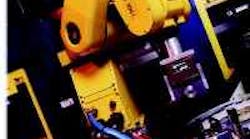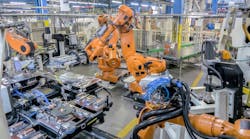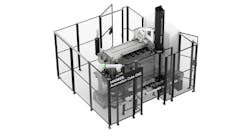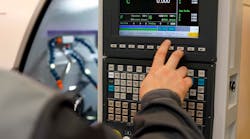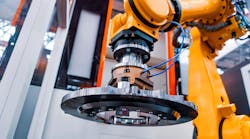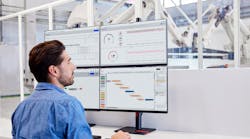What you need to know before purchasing the machines that mind machines.
Mennie's (www.mennies.com) uses robotic automation to achieve higher production speed and quality.
Mennie's system incorporates a series of flexible robotic workcells linked through a common part transfer conveyor.
An M-6i robot automatically picks raw parts from a conveyor and places them into a CNC lathe for machining.
Mennie's automated system is expandable to accommodate additional machines or new part designs.
Robots can be a quick way to automate a shop, boosting production, improving part handling, and freeing work-ers from backbreaking manual labor. However, not every shop should or could use a robot. The choice whether to automate or not really boils down to the parts being handled, the machine tools being used, the material flow throughout a cell, and the shop floor layout.
A shop that has been through the process of evaluating robots is Mennie's Machine Company Inc., an Illinois firm specializing in low to high-volume subcontract manufacturing of machined castings and forgings for the heavy construction, off-road equipment, and automotive markets. Founded in 1970 by Hubert and Cheryl Mennie, the company has approximately 200 employ-ees and operates roughly 95 machine tools.
Mennie's loaded all its machines manually, but found that human limitations kept it from reaching the throughput and consistency requirements needed to manufacture automotive drive-shaft components for sport utility vehicles and full-size trucks. In addition, the company had safety and ergonomic concerns about having its employees heft the 5-lb parts.
The three-shift, manual operation typically yielded 80 pieces per hour, nowhere near Mennie's production goal of 118 pieces an hour. "In order to position ourselves as a world-class manufacturer, we needed to implement leading-edge technology," says Mennie's vice president Bill Mennie.
For this production-improvement project, speed and quality were the company's highest priorities. Mennie's wanted to retrofit an existing line that, once completed, would connect 10 consecutive processes with material handling robots. The challenge was keeping the line going as the integration was taking place. This is where Fanuc Robotics North America Inc. of Rochester Hills, Mich., came in.
Parts perfect for automation
According to Andy Glaser, Fanuc district manager, shops considering automation should think robotics if their parts are heavy or awkward to handle. Automation also works well when a part is one of a family of similar size and shape. Part families usually minimize the time spent changing robot gripper fingers or setting up a conveyor to accept different parts.
How parts are processed is another key indicator of whether or not to call for robots. Are there multiple machining operations that can be combined and serviced by one robot? Are multiple stations involved? Does the production volume require multiple machines performing the same operations? More than one shift? These are all questions to ask.
A shop may be a good candidate for automation if its machine utilization uptime is less than 90%. Explains Glaser: "You're generally going to get about 95% efficiency with a robot. That's not taking into account if the customer has to change cutting tools on the machine tool. Adding robots to existing machine tools lets you process more parts with greater uptime."
For Mennie's, production complexity was a key factor in the decision to go with robots. In addition to the many different processes and types of machinery involved in the production of finished parts, the company wanted to balance cycle times between each process. With the manual operation, it became dif-ficult to overcome bottlenecks in the system, preventing the company from achieving its desired production goals.
Are the machine tools ready?
Of course, the part is not the only consideration when purchasing robots. The machine tools that the robots will be servicing play a key role. Kevin Bliss, Fanuc engineering manager, recommends that shops have machine tools with fixturing that clamps/ unclamps automatically, automatic doors, and physical I/O points for controlling external devices. Also, there should be logic in the PMC for interfacing with a robot.
Glaser adds that, in general, most any machine tool can be retrofitted with a robot. "We have customers with pre-CNC machines that are being serviced by robots. Older machines, though, are often more costly to retrofit and the automation can take more work."
When Mennie's retrofitted its machining cell, it had to deal with diverse processes: a facing and centering operation, turning, broaching, boring, reaming, drilling, spline rolling, heat treating, and grinding. Some machines, such as the face-and-centering system, were built by Mennie's and used Allen-Bradley PLCs. Other machines, including Mennie's Daewoo lathes and Haas machining centers, employed CNCs.
Where it could, Mennie's involved both Fanuc Robotics and the machine tool builder for a specific machine. But with some of the machines, like the specialty face-and-center system, Mennie's relied on its own engineers and the Fanuc Robotics personnel.
Bill's brother, David Mennie, also a vice president, says Mennie's ran seven days a week, 24 hours a day throughout the integration. The biggest challenge, he says, was to incorporate the automation without missing any deliveries.
Material flow
How parts come into and leave a workcell is one of the most important questions to answer before deciding on a robotic system. Says Glaser, "You will stifle a system pretty quickly if you don't have your material flow optimized."
The flow of materials can be simple, using one infeed and one outfeed conveyor or even a couple of pallets — one for raw parts and one for finished pieces. The situation, though, becomes more complicated as machines are added or if there are a number of different processes going on in one cell.
The following are some of the questions a company should ask itself about material flow:
- Are the parts introduced to the system raw or processed?
- Are they shipped into the facility in bulk?
- Are the raw parts processed in-house?
- How are the parts transferred from previous in-house processing (conveyor or dunnage)?
- Are parts gaged or turned over and put into machines?
- How many parts does a company want in queue?
- How long can an unmanned system run before it's starved of parts?
- What happens to the part after machining? (If they stay in-house for further processing, how are they transported? If they are shipped out, how are they packaged?)
After asking itself these questions, Mennie's decided it needed a series of robotic workcells linked through a common part transfer conveyor. It bought a new Flex-Line conveyor system fast enough to feed the material handling robots. Proximity switches tell the robots where the parts are on the conveyor belt.
Each robot is equipped with HandlingTool and Collision Guard software, custom grippers, and a control interface to the equipment and conveyor. The HandlingTool package's built-in functions, menu-driven prompts, and point-and-shoot position teaching make it easy for operators to create and run programs. Collision Guard lets a robot sense a potential collision along any axis and stops robot operation in time to minimize damage to the end-of-arm-tooling, the part, or the robot.
To start, raw parts are manually loaded into the company's specialty face-and-center machine before being conveyed downstream through nine automated machining processes. At each stop along the conveyor, the robots automatically load and un-load parts in an average of 6 sec.
First, an M-6i robot, capable of lifting up to 13.2 pounds, picks raw parts and places them into a CNC lathe for machining. It then moves finished parts onto a part pallet located on the conveyor. Next, each full part pallet travels to an LR Mate 100i tabletop robot, which loads and unloads parts into and out of a small broach machine. In the second process, another M-6i alternately loads and unloads parts onto one of two fixtures of a large broach machine for further processing.
A third M-6i then moves parts into and out of a boring operation.
In the final processes, an S-430iF, which can lift up to 286 lb, sequentially loads and unloads parts into and out of four machines that perform various groove and ream operations. Following this operation, parts are handled by a fourth M-6i robot to and from a drilling operation, then conveyed to another LR Mate 100i for a spline roll machining process. Next, an M-16i robot, capable of lifting up to 35 lb, lifts parts two at a time into a heat-treat operation. Finally, a fifth M-6i collects parts for grinding.
Robot selection
Obviously, how parts are loaded and unloaded determines what robot is eventually selected. Glaser says that the selection is based on six parameters: envelope/stroke, mounting, dexterity, floorspace, payload, and gripper type.
Envelope is defined as the maximum overall area that the robot arm has the ability to move within. Stroke, on the other hand, is the linear working area between the farthest and closest point the robot can reach. "Just because a robot has a lot of reach, it still might not be the right one for a given job," says Glaser, "be-cause it may not have the type of envelope needed."
Mounting also plays an important role, says Glaser, because some robots are limited to how they are mounted. "In some cases, you can actually improve the envelope relative to a specific machine by doing something like mounting the robot upside down," explains Glaser.
Mounting refers to how the robot can be positioned within the workcell: on the floor, upside down, on a wall, or on a rail. Both envelope and stroke determine how a robot is mounted.
Dexterity means that the robot can manipulate something in space without any limitations — usually in 4, 5, and 6 axes. "With a fifth axis, you don't have many limitations on how you can put a part into a machine," explains Glaser. "With four axes, you can only move a part in X, Y, and Z and rotate it in one axis. The robot can't rotate the part with X or Y rotation direction, which drastically reduces the mobility of the robot motion." That's why most machine load/unload robots are six axis.
In regards to floorspace, the idea is to keep the robot out of the way. Obviously, shops need to reach machine tools for maintenance. Overhead-mounted systems, if suitable, are one way to optimize floorspace.
Payload refers to the weight the robot can pick up, but it isn't only the weight of the part being handled. It also includes the robot's gripper, which can weigh 100 lb in some cases. The largest robot Fanuc Robotic makes can handle an 880-lb payload.
Gripper designs are driven by the type of parts handled and the processes performed. Designs include side-by-side, back-to-back, or single-hand, for example, but, says Glaser, they are difficult to standardize because parts are different for every application. In fact, gripper fingers are almost always customized depending on factors such as part shape and size as well as how a part is loaded into a machine tool.
Other considerations
Fanuc Robotics suggests companies study their buildings to see if they have sufficient overhead clearance and enough space for safety barriers. The robotic work-cell should be accessible either by fork truck or conveyors. There should also be plenty of room for robot and machine tool maintenance operations.
When all the physical logistics are settled, shops should plan to train their personnel. For example, Mennie's sent employees to Fanuc Robotics for training; they then returned to instruct the other workers.
The final story
Now that the robots are in place, production is humming at Mennie's with the operation running at 95% uptime, a 15% increase. The shop estimates that the robotic system has helped reduce total production costs by approximately 25% and slash scrap rates.
Production flexibility has also improved. Not only is the system expandable to accommodate additional machines, but with slight modifications to fixtures, the system could easily accommodate new part designs. As a plus, Mennie's can also switch back to manual production during routine preventive maintenance.
The blind now see
VisLOC provides a simple interface for setup and operation of 2D and 3D material handling applications. A straightforward windowing technique trains parts for vision.
Robots are blind, so the only way to ensure a part is loaded correctly is by knowing the part's orientation before a robot picks it up. Users have plenty of options — two of which are sensors and conveyor systems with tooling built into them. However, the trend in the metalworking industry is to use vision systems, which may provide more flexibility than the other options. This is because parts don't have to be presented in a fixed position on a conveyor system or pallet.
Mennie's Machine Co. is planning on integrating vision systems into its operations within the next couple of years. "Our first goal is to save a lot of money," says Bill Mennie. "Where we now need a special cart or locating fixture, we will be able to use a standard conveyor and Fanuc's new vision system," he explains.
In just the past year, Fanuc Robotics has introduced two vision systems to the market. The first, visLOC, is a recently released PC-based robotic vision system that determines an object's location and orientation. It features a complete graphical, Windows-style setup environment, making it simple to set up, calibrate, train, and run.
VisLOC, with a simplified, automatic circle-grid calibration process, lets users calibrate cameras in just minutes. Its vision tools are powered by PatMax, an algorithm supplied by Cognex, that provides reliable object location for most robotic vision applications. PatMax compensates for part rotation, size variations, and changes in appearance.
Fanuc Robotics also offers the Fanuc Vision Integrator Package (VIP), a PC-based product for robotic vision application development.
"The VIP is a system integrator's package providing vision tools and hardware for development of custom robotic vision applications," remarks Ed Roney, senior product manager at Fanuc Robotics. The package combines Fanuc Robotics' robotic guidance technology with Cognex Corporation's machine vision software. VIP works in machine load/unload, assembly, material handling, inspection, and other applications requiring process feedback.
The system operates on a standard PC platform and connects to the robot controller via a serial inter-face. This robotic vision system works with all Fanuc robot models and integrates to Fanuc R-J2, R-J3, and R-J2 SYSTEM Mate controllers.
